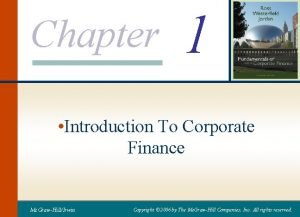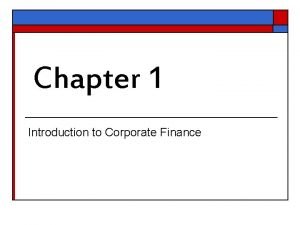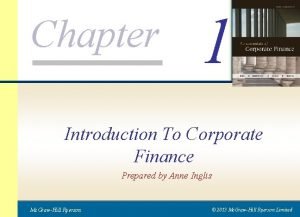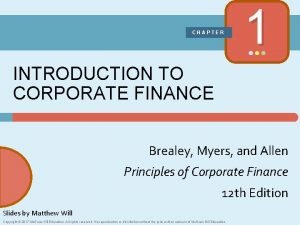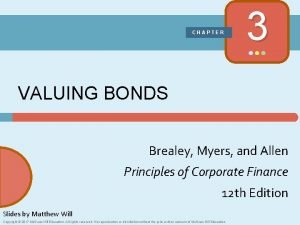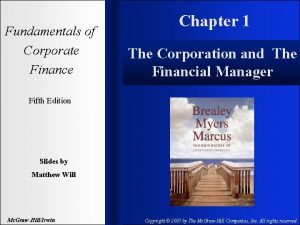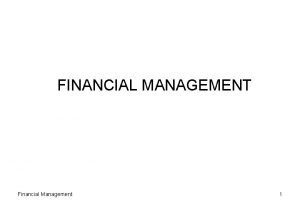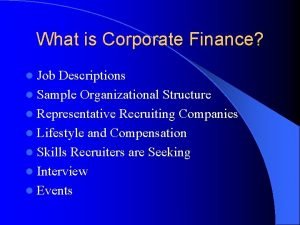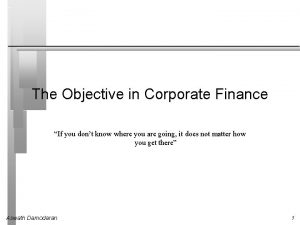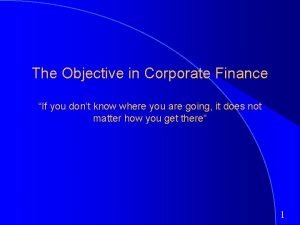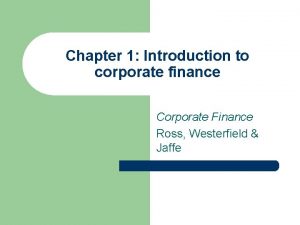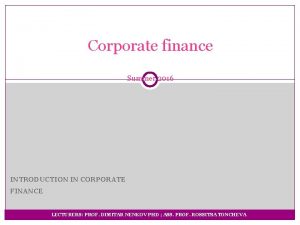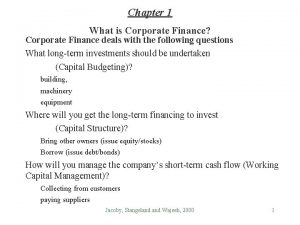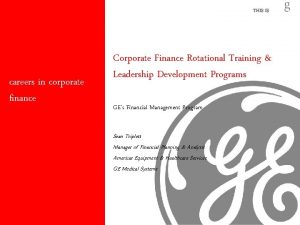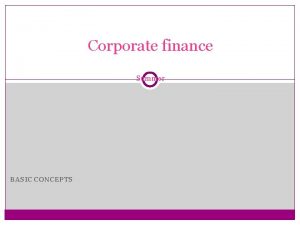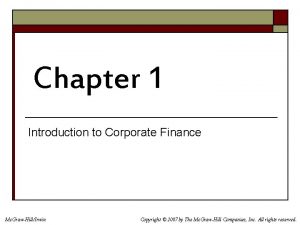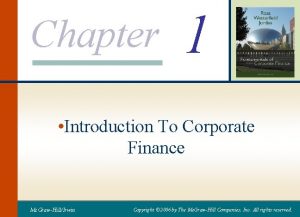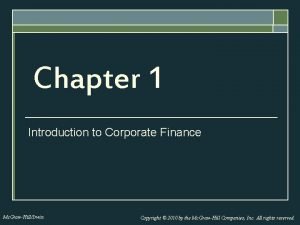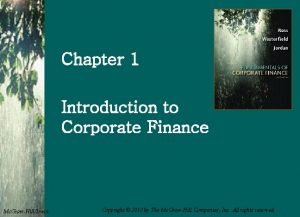Chapter 1 Introduction To Corporate Finance Mc GrawHillIrwin
















- Slides: 16

Chapter 1 • Introduction To Corporate Finance Mc. Graw-Hill/Irwin Copyright © 2006 by The Mc. Graw-Hill Companies, Inc. All rights reserved.

Chapter Outline • • • Finance Corporate Finance and the Financial Manager Forms of Business Organization The Goal of Financial Management The Agency Problem and Control of the Corporation Financial Markets and the Corporation 1 -1

Finance • Corporate Finance: Managing a corporate’s cash flows • Investment: Securities’ cash flows • Financial institutions • Financial Derivatives: Financial products based the underlying asset such as stocks • Corporate Valuation: Valuation of corporate’s cash flows • International (Corporate) Finance: Corporate finance in global markets • Project finance 1 -2

Corporate Finance • Major financial issues or questions of financial managers (CFO) • What long-term investments should the firm take on? → Investment Issue (Capital budgeting) • Where will we get the long-term financing to pay for the investment? → (Capital structure) • Debt/Equity, Dividend policy • How will we manage the everyday financial activities of the firm? → Working capital management (Shortterm financing Issue) 1 -3

Financial Manager • Financial managers try to answer some or all of these questions • The top financial manager of a firm is usually called as the Chief Financial Officer (CFO) • Treasurer – oversees cash and credit management, capital expenditures and financial planning • Controller – oversees taxes, cost accounting, financial accounting and data processing 1 -4

Forms of Business Organization • Three major forms • Sole proprietorship • Partnership • General • Limited • Corporation • Limited liability company 1 -5

Sole Proprietorship • Advantages • Easiest to start • Least regulated • Single owner keeps all the profits • Taxed once as personal income • Disadvantages • Limited to life of an owner • Equity capital limited to a owner’s personal wealth • Unlimited liability • Difficult to sell ownership interest 1 -6

Partnership • Advantages • • Two or more owners More capital available Relatively easy to start Income taxed once as personal income • Disadvantages • General partnership • Unlimited liability • Limited partnership • General partner + Limited partner • Partnership can dissolve when one partner dies or wishes to sell. • Difficult to transfer ownership 1 -7

Corporation • Advantages • Limited liability • Unlimited life • Separation of ownership and management • Transfer of ownership is easy • Easier to raise capital • Disadvantages • Separation of ownership and management • Double taxation (income taxed at the corporate and then dividends taxed at the personal rate) 1 -8

Goal of Financial Management • What should be the goal of a corporation? • • • Maximize profit? Minimize costs? Maximize market share? Maximize the current value of the company’s stock? Maximize benefits of stakeholders such as equityholders, employees, suppliers and so on. • Does this mean we should do anything and everything to maximize owner wealth? 1 -9

The Agency Problem • Agency relationship • Principals (owners) hire an agent to represent his/her interest. • Stockholders (principals) hire managers (agents) to run the company. • Agency problem • Conflict of interest between principal and agent • Management goals and agency costs 1 -10

How to align managers’ Interests to stockholders’ ? • Board of Directors • Managerial compensation • Incentives can be used to align management and stockholder interests. • The incentives need to be structured carefully to make sure that they achieve their goal. • Corporate control • The threat of a takeover may result in better management. 1 -11

Work the Web Example • The Internet provides a wealth of information about individual companies • One excellent site is finance. yahoo. com • Click on the web surfer to go to the site, choose a company and see what information you can find! 1 -12

Financial Markets • Cash flows to the firm • Primary vs. secondary markets • auction markets vs. Dealer • Listed vs. over-the-counter securities • NYSE • NASDAQ 1 -13

Quick Quiz • What are three types of financial management decisions and what questions are they designed to answer? • What are three major forms of business organization? • What is the goal of financial management? • What are agency problems and why do they exist within a corporation? • What is the difference between a primary market and a secondary market? 1 -14

Chapter 1 • End of Chapter Mc. Graw-Hill/Irwin Copyright © 2006 by The Mc. Graw-Hill Companies, Inc. All rights reserved.
 Corporate finance objectives
Corporate finance objectives Introduction to corporate finance what companies do
Introduction to corporate finance what companies do Chapter 1 introduction to corporate finance
Chapter 1 introduction to corporate finance Chapter 1 introduction to corporate finance
Chapter 1 introduction to corporate finance Chapter 1 introduction to corporate finance
Chapter 1 introduction to corporate finance Corporate finance quiz
Corporate finance quiz Fundamentals of corporate finance chapter 6 solutions
Fundamentals of corporate finance chapter 6 solutions Fundamentals of corporate finance chapter 1
Fundamentals of corporate finance chapter 1 Principles of corporate finance chapter 3 solutions
Principles of corporate finance chapter 3 solutions Fundamentals of corporate finance, chapter 1
Fundamentals of corporate finance, chapter 1 Modern finance theory
Modern finance theory Tom sanzillo
Tom sanzillo Corporate finance vs investment banking
Corporate finance vs investment banking Corporate finance job scope
Corporate finance job scope Objective of corporate finance
Objective of corporate finance Objective of corporate finance
Objective of corporate finance Objective of corporate finance
Objective of corporate finance

